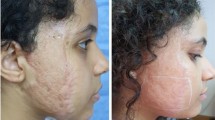Abstract
Management of facial post-burn hyperpigmentation is a common and challenging problem for dermatologists and plastic surgeons. The recent development of micro-plasma radiofrequency technology, which allows precise and rapid treatment with controlled thermal injury, can be an effective treatment of post-burn hyperpigmentation. This study aimed to evaluate the effectiveness and complications of micro-plasma radiofrequency treatment of post-burn hyperpigmentation. The study included 35 patients with Fitzpatrick skin type III or IV and facial post-burn hyperpigmentation. Patients received three to five treatments at 8-week intervals. A roller tip was used with the power setting at 60–90 W, and 3–4 passes were made in different directions. The degree of improvement and complications were recorded. Improvement of hyperpigmentation was evaluated by patient self-assessment and by plastic surgeons who compared digital photographs taken before treatment and 2 months after the last treatment. The results showed that post-burn hyperpigmentation responded favorably to micro-plasma radiofrequency treatment with very few complications. The average pain score using a visual analog scale from 0 to 10 was 6.7 ± 0.7. After a series of treatments, 32 of the 35 patients had achieved a >51 % improvement of their hyperpigmentation, and 3 patients had achieved a fair improvement. The mean score for improvement of hyperpigmentation was 4.28. Patient self-evaluations indicated good satisfaction with the cosmetic outcomes, and some softening of the scars. Micro-plasma radiofrequency technology is appropriate, effective, and safe for the treatment of facial post-burn hyperpigmentation, and provides a promising noninvasive treatment for superficial facial injuries.



Similar content being viewed by others
References
Woolery-Lloyd H, Kammer JN (2011) Treatment of hyperpigmentation. Semin Cutan Med Surg 30:171–175
Alghamdi KM (2010) The use of topical bleaching agents among women: a cross-sectional study of knowledge, attitude and practices. J Eur Acad Dermatol Venereol 24:1214–1219
Kang HY, Valerio L, Bahadoran P, Ortonne JP (2009) The role of topical retinoids in the treatment of pigmentary disorders: an evidence-based review. Am J Clin Dermatol 10:251–260
Halachmi S, Haedersdal M, Lapidoth M (2014) Melasma and laser treatment: an evidenced-based analysis. Lasers Med Sci 29:589–598
Chan NP, Ho SG, Shek SY, Yeung CK, Chan HH (2010) A case series of facial depigmentation associated with low fluence Q-switched 1,064 nm Nd: YAG laser for skin rejuvenation and melasma. Lasers Surg Med 42:712–719
Chan HH, Manstein D, Yu C, Shek S, Kono T, Wei WI (2007) The prevalence and risk factors of post-inflammatory hyperpigmentation after fractional resurfacing in Asians. Lasers Surg Med 39:381–385
Nanni CA, Alster TS (1998) Complications of carbon dioxide laser resurfacing. An evaluation of 500 patients. Dermatol Surg 24:315–320
Halachmi S, Orenstein A, Meneghel T, Lapidoth M (2010) A novel fractional micro-plasma radio-frequency technology for the treatment of facial scars and rhytids: a pilot study. J Cosmet Laser Ther 12:208–212
Gonzalez MJ, Sturgill WH, Ross EV, Uebelhoer NS (2008) Treatment of acne scars using the plasma skin regeneration (PSR) system. Lasers Surg Med 40:124–127
Foster KW, Moy RL, Fincher EF (2008) Advances in plasma skin regeneration. J Cosmet Dermatol 7:169–179
Kono T, Groff WF, Sakurai H, Yamaki T, Soejima K, Nozaki M (2009) Treatment of traumatic scars using plasma skin regeneration (PSR) system. Lasers Surg Med 41:128–130
Higashimori T, Kono T, Sakurai H, Nakazawa H, Groff WF (2010) Treatment of mesh skin grafted scars using a plasma skin regeneration system. Plast Surg Int. doi:10.1155/2010/874348
Kawada A (2000) Risk and preventive factors for skin phototype. J Dermatol Sci 23:S27–S29
Wu XL, Gao Z, Liu K, Xia LL, Bao YF, Ruan J, Liu W (2011) Clinical efficacy of acne scar treatment with micro-plasma radio frequency. Zhonghua Yi Xue Za Zhi 91:2604–2606
Holcomb JD, Kent KJ, Rousso DE (2009) Nitrogen plasma skin regeneration and aesthetic facial surgery: multicenter evaluation of concurrent treatment. Arch Facial Plast Surg 11:184–193
Hruza G, Taub AF, Collier SL, Mulholland SR (2009) Skin rejuvenation and wrinkle reduction using a fractional radiofrequency system. J Drugs Dermatol 8:259–265
Fitzpatrick R, Bernstein E, Iyer S, Brown D, Andrews P, Penny K (2008) A histopathologic evaluation of the plasma skin regeneration system (PSR) versus a standard carbon dioxide resurfacing laser in an animal model. Lasers Surg Med 40:93–99
Conflicts of interest
The authors declare no conflicts of interest.
Author information
Authors and Affiliations
Corresponding author
Additional information
Lian-Zhao Wang and Jin-Ping Ding contributed equally in this study.
Rights and permissions
About this article
Cite this article
Wang, LZ., Ding, JP., Yang, MY. et al. Treatment of facial post-burn hyperpigmentation using micro-plasma radiofrequency technology. Lasers Med Sci 30, 241–245 (2015). https://doi.org/10.1007/s10103-014-1649-6
Received:
Accepted:
Published:
Issue Date:
DOI: https://doi.org/10.1007/s10103-014-1649-6




